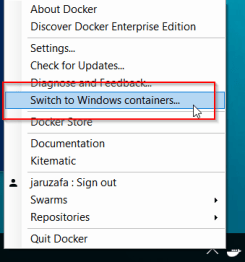Debugging Delphi applications inside a Windows Docker container
27/02/2018 / JARUZAFA
27/02/2018 / JARUZAFA
[SHOWTOGROUPS=4,20]

Hi there! Ever wondered how to deploy delphi applications inside a Windows Docker container? And how to debug them once they’re inside the container? Search no more! I will explain how to run a Windows Docker container with PAServer up and running, ready to debug your applications.
This can came in handy when:
The fast way
To follow this tutorial you’ll need:
Under the hood
So you want to know what’s going on to hack it and customize for your own needs, right? Good, I love your attitude. Let’s go and take a look on what you need to debug delphi apps in a container.
The image
First of all we need to build an image with windows and PAServer installed and running. This Dockerfile will do the job:
It downloads the PAServer setup package from Embarcadero servers, installs it, expose the port 64211, and starts paserver.exe
Pretty straightforward don’t you think? But wait… what’s that install_paserver.bat? why don’t just call setup_paserver.exe?
For some reason (unkown to me), setup_paserver.exe returns an error code=1, when running on silent mode. That error code breaks the docker build, so I came up with an install_paserver.bat that forces error code to 0:
So far so good! Build the image (mind the point ‘.’ at the end, it’s important):
After a while you’ll have the docker image, named “paserverwindows”.
The container
Now that you have the image, your next step is running it:
RadStudio side
That’s it. It just works like a regular Remote Debugging project. You may name your container with a hostname using the -h parameter.
If you want to tune your PAServer with a password or a custom port you’ll need to copy out configuration file. If you need more info, go to Для просмотра ссылки Войдиили Зарегистрируйся.
Some thoughts
[/SHOWTOGROUPS]

Hi there! Ever wondered how to deploy delphi applications inside a Windows Docker container? And how to debug them once they’re inside the container? Search no more! I will explain how to run a Windows Docker container with PAServer up and running, ready to debug your applications.
This can came in handy when:
- Your service/app/… works great, but it fails miserably when it’s executed in a container and you need to debug it
- You want a quick & dirty deploy way of your service/app/… into a container, without the hassle of building a Dockerfile
The fast way
To follow this tutorial you’ll need:
- Для просмотра ссылки Войди
или Зарегистрируйся - Для просмотра ссылки Войди
или Зарегистрируйся - 5 minutes
- Run Docker for Windows
- In context menu: Switch to Windows containers
-
- Open powershelland run:
- docker pull jaruzafa/paserverwindows
- docker run -d -h mypaserver jaruzafa/paserverwindows
- Now you have a Docker Windows container running PAServer at default port (64211) on host “mypaserver”
- Fire up RadStudio and open your project (or a console blank project just for testing)
- Right-click on your target plataform (Windows 32 or 64) and select “Properties”
- At “Profile” combo select “Add New...”
- Hostname: mypaserver
- Port: 64211
- No password
-
- Important! If your target platform is Windows 32 make sure that: Project->Options->Delphi compiler->Linking->Include remote debug symbols->TRUE(otherwise you’ll get an error, eventually)
-
- Click OK and set a breakpoint on your code.
- Run with debug (or press F9) and wait until your breakpoint is reached
- Enjoy the life
Under the hood
So you want to know what’s going on to hack it and customize for your own needs, right? Good, I love your attitude. Let’s go and take a look on what you need to debug delphi apps in a container.
The image
First of all we need to build an image with windows and PAServer installed and running. This Dockerfile will do the job:
Код:
FROM microsoft/windowsservercore
ADD install_paserver.bat /paserver/install_paserver.bat
ADD http://altd.embarcadero.com/releases/studio/19.0/PAServer/Release2/setup_paserver.exe /paserver
WORKDIR /paserver
RUN install_paserver.bat
EXPOSE 64211
CMD ["/Program Files (x86)/Embarcadero/PAServer/19.0/paserver.exe"]It downloads the PAServer setup package from Embarcadero servers, installs it, expose the port 64211, and starts paserver.exe
Pretty straightforward don’t you think? But wait… what’s that install_paserver.bat? why don’t just call setup_paserver.exe?
For some reason (unkown to me), setup_paserver.exe returns an error code=1, when running on silent mode. That error code breaks the docker build, so I came up with an install_paserver.bat that forces error code to 0:
Код:
setup_paserver.exe -i silent
exit /b 0So far so good! Build the image (mind the point ‘.’ at the end, it’s important):
Код:
docker build -t paserverwindows .After a while you’ll have the docker image, named “paserverwindows”.
The container
Now that you have the image, your next step is running it:
Код:
docker run -d -h mypaserver paserverwindowsRadStudio side
That’s it. It just works like a regular Remote Debugging project. You may name your container with a hostname using the -h parameter.
If you want to tune your PAServer with a password or a custom port you’ll need to copy out configuration file. If you need more info, go to Для просмотра ссылки Войди
Some thoughts
- Source is available at Для просмотра ссылки Войди
или Зарегистрируйся - Unfortunately, I couldn’t use microsoft/nanoserver image (just sized 1GB) because it lacks of 32-bit Runtime, needed for PAServer.
- You can run the container in interactive modewith:
- docker run -i -h mypaserver jaruzafa/paserverwindows
- But…. the console interface is quite laggy and it turn to be unusable. I have not found a solution to this, but if you come up with one, please leave a comment.
[/SHOWTOGROUPS]


